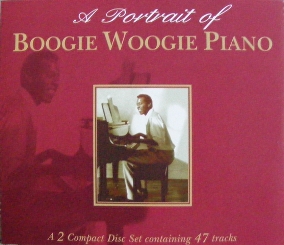A Portrait Of Boogie Woogie Piano (USA Blues 1929-49)
A Portrait Of Boogie Woogie Piano (USA Blues 1929-49) (1997)

CD1 1 Pinetop Smith - Pinetop´s Boogie Woogie play 2 Jimmy Blythe - Chicago Stomps 3 Charles "Cow Cow" Davenport - Cow Cow Blues 4 Charles "Cow Cow" Davenport - Chimes Blues 5 Jimmy Yancey - Five O´clock Blues 6 Hersal Thomas - The Fives 7 Albert Ammons - Suitcase Blues play 8 Meade Lux Lewis - Honky Tonk Train Blues 9 Charles Avery - Dearborn Street Breakdown 10 Cripple Clarence Lofton - I Don´t Know 11 Montana Taylor - Detroit Rocks 12 Will Ezell - Heifer Dust 13 Blind Leroy Garnett - Chaim ´Em Down 14 Rufus "Speckled Red" Perryman - St. Louis Stomp 15 Bob Call - Thirty-one Blues 16 Jabo Williams - Pratt City Blues 17 Dot Rice - Texas Stomp 18 Little Brother Montgomery - Farish Street Jive 19 James P. Johnson - Carolina Shout 20 Willie "The Lion" Smith - Echoes of Spring 21 Fats Waller - Handful of Keys 22 Fats Waller - Honeysuckle Rose 23 Fats Waller - Ain´t Be Misbehavin CD2 1 Cleo Brown - Pinetop´s Boogie Woogie 2 Albert Ammons - Boogie Woogie Stomp 3 Albert Ammons - St. Louis Blues 4 Meade Lux Lewis - Mr. Freddie Blues 5 Meade Lux Lewis - Six Wheel Chaser 6 Pete Johnson - Basement Boogie 7 Pete Johnson - Death Ray Boogie 8 Boogi Woogie Trio - Boogie Woogie Prayer 9 Jimmy Yancey - Yancey Stomp play 10 Jimmy Yancey - Slow and Easy Blues 11 Albert Ammons / Pete Johnson - Sixth Avenue Express 12 Albert Ammons / Pete Johnson - Barrelhouse Boogie 13 Albert Ammons - The Boogie Rocks 14 Pete Johnson - Dive Bomber 15 Jay McShann - Hold´em, Hootie 16 Lionel Hampton - Central Avenue Breakdown 17 Cecil Gant - Cecil Boogie 18 Earl Hines - On the Sunny Side of the Street 19 Joe Turner - Cheek To Cheek 20 Herman Chittison - St. Louis Blues 21 Art Tatum - Tiger rag play 22 Fats Waller - Smashing Thirds 23 Fats Waller - Alligator Crawl 24 Fats Waller - Viper´s Drag
Boogie-woogie is a style of piano-based blues that became popular in the late 1930s and early 1940s, but originated much earlier, and was extended from piano, to three pianos at once, guitar, big band, and country and western music, and even gospel. Whilst the blues traditionally depicts a variety of emotions, boogie-woogie is mainly associated with dancing. It is characterized by a regular bass figure, in the left hand.
It is not strictly a solo piano style, but is also used to accompany singers and as a solo part in bands and small combos. It is sometimes called "eight to the bar", as much of it is written in common time (4/4) time using eighth notes (quavers).
Boogie-woogie gained further public attention in 1938 and 1939, thanks to the From Spirituals to Swing concerts in Carnegie Hall promoted by record producer John Hammond. The concerts featured Big Joe Turner and Pete Johnson performing Turner's tribute to Johnson, "Roll 'Em Pete", as well as Meade Lux Lewis performing "Honky Tonk Train Blues" and Albert Ammons playing "Swanee River Boogie". "Roll 'Em Pete" is now considered to be an early rock and roll song.
These three pianists, with Turner, took up residence in the Café Society night club in New York City where they were popular with the sophisticated set. They often played in combinations of two and even three pianos, creating a richly textured piano performance.
Amongst the many pianists who have been exponents of this genre, there are only a few who have had a lasting influence on the music scene. Perhaps the most well known boogie-woogie pianist is Albert Ammons. His "Boogie Woogie Stomp" released in 1936 was a pivotal recording, not just for boogie-woogie but for music. Some of the flattened sevenths in the right hand riffs are similar to licks used by early rock and roll guitarists. Ammons' two main compatriots were Meade 'Lux' Lewis and Pete Johnson. Before these three were playing piano, the two leading pianists were Jimmy Yancey and 'Pine-Top' Smith. Both of these pianists used bass patterns similar to ragtime and stride piano, but the distinctive Boogie-Woogie right hand licks were already in use. Today, Boogie-Woogie is being taken forward by such pianists as Rob Rio, Silvan Zingg and particularly Axel Zwingenberger, whose records and performances have a great influence on the contemporary scene.
Boogie-woogie - styl gry fortepianowej zapoczątkowany przez Afroamerykanów, przeważnie w instrumentalnym bluesie, z charakterystycznymi, mocnymi figurami basowymi. Rozwinął się po 1920 roku w Chicago i St. Louis.
Styl wywodzi się z instrumentalnego bluesa, przy czym często w pierwszej fazie jego rozwoju zdarzały się formy pograniczne, sąsiadujące ze stylem ragtime oraz stride piano. Utworem przełomowym jest Pinetop's Boogie (1928), ponieważ występuje tu po raz pierwszy nazwa tego stylu. Figury basowe i melodyjne bywają bardzo żywe, powodując u słuchaczy wesoły nastrój.
Od niego swoją nazwę wziął swingujący taniec towarzyski pochodzący od tańca boston. Jest to taniec bardzo dynamiczny, o dużym zakresie ruchów. Obecnie tańczony zarówno do stylu muzycznego boogie-woogie, jak i, częściej, do rock and rolla.
Głównymi przedstawicielami boogie-woogie byli Albert Ammons, Meade Lux Lewis oraz Pete Johnson. Grywali często razem, a ich legendarnym koncertem był wspólny występ w Nowym Jorku w Carnegie Hall (1938). Po tym wydarzeniu odźwierni musieli rzekomo poprosić niektórych uczestników koncertu, by zeszli z żyrandoli, na które się powspinali.
download (mp3 @320 kbs):
yandex mediafire ulozto bayfiles
Last Updated (Wednesday, 04 November 2020 18:12)








